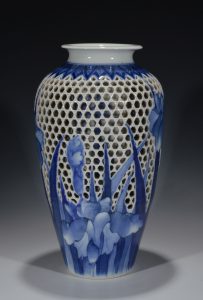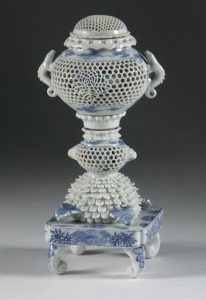Within the Ackland Art Museum’s Colors Across Asia exhibit, ceramic works sit staged throughout a variety of cases, the medium functioning as a kind of material chameleon. In some displays, clay appears in the form of functional, everyday objects we can identify at a glance like plates, bowls, and vases – the forms we expect it to take. More surprising works, like Nagae Shigekazu’s Object, speak to decorative, and yet abstract, potential of ceramic works in allowing the materiality of such an ethereal medium give the work its own aura.
 Winding my way through the abundance of objects I could choose from, I found myself drawn to an impressive porcelain sculpture of a hawk, perched on a rock.
Winding my way through the abundance of objects I could choose from, I found myself drawn to an impressive porcelain sculpture of a hawk, perched on a rock. Executed using a cobalt blue underglaze, the hawk’s design filled me with nostalgia, reminding me of my grandmother’s house and all of the porcelain she had brought with her from Korea. The hawk is a Japanese work, produced in the nineteenth century. Unlike many of the other works in this exhibit, the porcelain used to craft this sculpture is attributed to a particular place – Hirado, on the island of Kyushu in southwest Japan. Further research revealed that Hirado was the site of remarkable mastery in porcelain, traditionally adorned with this blue underglaze. In the first half of the nineteenth century, the kilns and potters at Hirado received patronage from local warlords. Later, around 1850, they began to see an increase in European interest, as sophisticated Western buyers sought their wares. Known for their impressive detail and technical complexity, Hirado porcelain has long been lauded for its size, intricacy, and exemplary use of the medium.
Executed using a cobalt blue underglaze, the hawk’s design filled me with nostalgia, reminding me of my grandmother’s house and all of the porcelain she had brought with her from Korea. The hawk is a Japanese work, produced in the nineteenth century. Unlike many of the other works in this exhibit, the porcelain used to craft this sculpture is attributed to a particular place – Hirado, on the island of Kyushu in southwest Japan. Further research revealed that Hirado was the site of remarkable mastery in porcelain, traditionally adorned with this blue underglaze. In the first half of the nineteenth century, the kilns and potters at Hirado received patronage from local warlords. Later, around 1850, they began to see an increase in European interest, as sophisticated Western buyers sought their wares. Known for their impressive detail and technical complexity, Hirado porcelain has long been lauded for its size, intricacy, and exemplary use of the medium.
The hawk perches stoically, its head turned back as if it had just sensed some prey scurrying in the brush behind it. The smooth fluidity of the porcelain forming the body of the bird almost gives the sense that the head could continue its path of movement at any moment. The artist precisely utilized the cobalt blue underglaze to produce a pattern of feathers, using various intensities of the blue to delineate between parts of the bird’s body; the light coloration of the feathers on the neck speak to a tactile softness that contrasts sharply with the more saturated blue used to create the pattern of sturdier feathers on the neck. The smooth, softness of the body of the hawk then sharply diverges from the boulder it perches on. The hawk’s textured feet and talons latch on to a deeply textured rock, incised with grooves and crevices and treated with glaze to give textural dimension.
The artist who produced this work clearly favored naturalization, which seems to be the style used to execute a substantial amount of Hirado porcelain. The size and detail of the work leads me to believe that the work was reductively produced from a block of clay, each curve and crevice incised with expert precision. The delicacy of the medium and hand of the artist alike speak to the long legacy of porcelain as an artistic tradition.